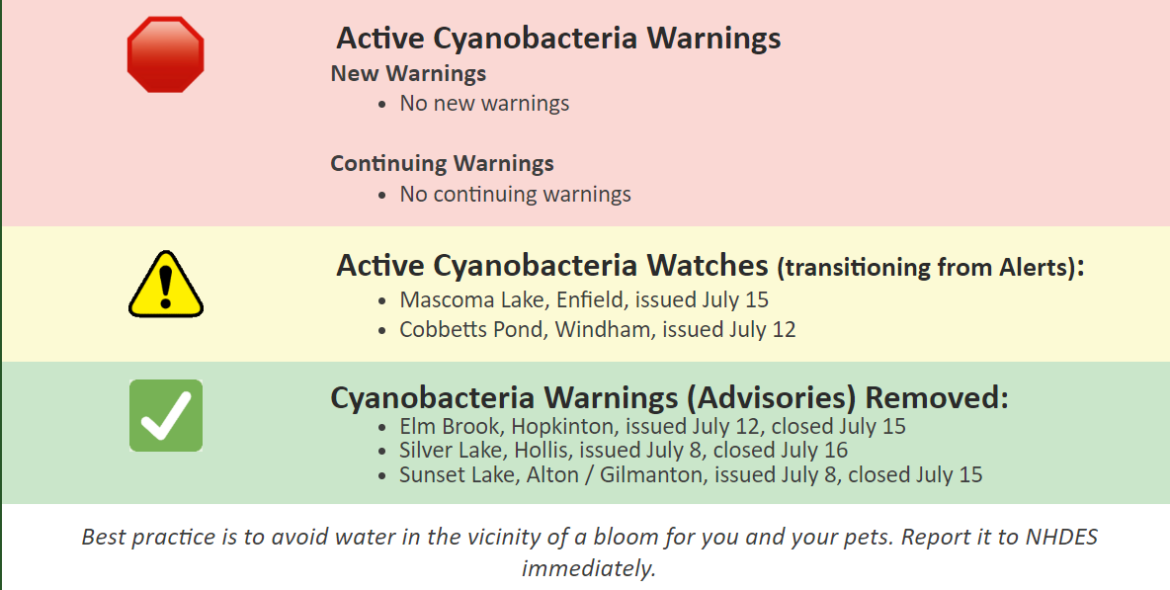NH DES Website to check for cyanobacteria: https://www.des.nh.gov/water/healthy-swimming/harmful-algal-blooms
NH DES News Release:
REMINDER: Lakes experiencing cyanobacteria blooms are still usable for boating or other activities. Individuals interested in swimming or wading should avoid areas with a green surface scum and water that is not clear.
Check out the NHDES Healthy Swimming Mapper for more details and daily updates: https://www.arcgis.com/apps/dashboards/8d84a6b03acb4efaab571b222c78447b
What is a Warning? Warnings are issued lake-wide when cyanobacteria cell counts exceed the recreational health threshold of 70,000 cells/mL. Surface blooms can rapidly change and accumulate in various locations around a waterbody.
Please continue to monitor shorelines for changing conditions. NHDES advises lake users to avoid contact with the water in the vicinity of blooms. Pets and livestock should also be kept out of the water. When a warning is issued, resampling is performed weekly until the bloom subsides. Warnings are issued from May 15 through October 15.
Warnings are intended as a precautionary measure for short term exposure to cyanotoxins. Because bloom conditions can rapidly change and move around in a waterbody, it is important to perform your own self-risk assessment by checking the healthy swimming mapper and looking at the water for discoloration or any unusual growth, such as clouds, ribbons, or flecks in the water, prior to recreating. If you see cyanobacteria develop after a warning has been closed, please report it.
What is a Watch (transitioning from Alert)? Watches (Alerts) are issued 1) based on a photo before NHDES can analyze a sample; 2) when the cyanobacteria density is approaching the recreational health threshold but does not yet exceed it; or 3) if a bloom was reported but may have passed by the time a sample was reviewed but could reoccur. Watches are intended to serve as statements to be on the watch for a potential cyanobacteria bloom. Waterbody users should avoid contact with bloom material and keep pets and livestock out of the water. Sometimes watches become warnings, and sometimes they pass. Watches remain active for a week. Resampling only occurs if further bloom reports are submitted.
Cyanobacteria Basics: Cyanobacteria are natural components of water bodies worldwide, though blooms and surface scums may form when excess nutrients are available to the water. When a cyanobacteria bloom occurs, the potential increases that exposure to the bloom may cause acute and chronic health effects. Acute health effects include irritation of the skin and mucous membranes, tingling, numbness, nausea, vomiting, seizures, and diarrhea. If a person or animal is sick from a potential cyanobacteria exposure, please seek medical attention. Inform your physician or veterinarian that you or your pet may have been exposed to toxic cyanobacteria via recreation.
Please also fill out our Illness Report Form, (updated spring 2024) and see the CDC guidance for Health Care Providers and Veterinarians. Questions? For more information, see the NHDES Harmful Algal Bloom Webpage and our Frequently Asked Questions (updated spring 2024). Sign up for waterbody- specific emails to receive more details for that specific waterbody (warning or watch issuance, resampling results and warning removal).





